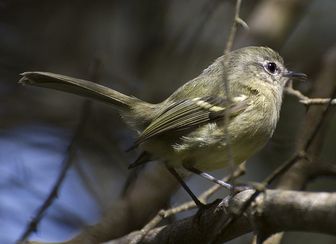Mottle-cheeked Tyrannulet

The Mottle-cheeked Tyrannulet is classified as Least Concern. Does not qualify for a more at risk category. Widespread and abundant taxa are included in this category.
The Mottle-cheeked Tyrannulet (Phylloscartes ventralis) is a generally common, small species of bird in the Tyrannidae family. It occurs in two disjunct populations, one associated with montane Atlantic Forest in south-eastern Brazil, eastern Paraguay, north-eastern Argentina and Uruguay, and another found in forest growing on the east Andean slope in Peru, Bolivia and north-western Argentina. A very active bird usually seen with its tail held cocked. References - * BirdLife International 2004. More
Mottle-cheeked Tyrannulet Phylloscartes ventralis = Described by: Temminck (1824) Alternate common name(s): Narrow-billed Tyrannulet, Slender-billed Tyrannulet Old scientific name(s): None known by website authors Photographs Itatiaia National Park, Rio de Janeiro, Brazil - Aug 14, 2007 More
active nest of Mottle-cheeked Tyrannulet Phylloscartes ventralis from southern Paraguay. Details of parental care behaviour for the nearly fledged young are provided. Possible adaptations towards crypticity in the breeding cycle of this species are discussed. Comparisons are made with documented accounts of the breeding behaviour of this species in other countries. This represents the first documentation of breeding behaviour of this species in Paraguay. More
MOTTLE-CHEEKED TYRANNULET Phylloscartes ventralis Click here for articles relating to this species. The Mottle-cheeked is one of those frustrating little greenish forest flycatchers with a yellow belly. They are active, hard to observe and not particularly mottle-cheeked!! Most of their foraging is done by flycatcher-gleaning, a technical term for flying and plucking a prey item from vegetation. FIGURE 1 - Adult, Hotel Tirol, Departamento Itap More
Mottle-cheeked Tyrannulet Phylloscartes ventralis = Itatiaia National Park, Rio de Janeiro, Brazil - Aug 14, 2007 More

Original source: Cl
Author: Cl
Permission: Some rights reserved
Family : Tyrannidae
Genus : Phylloscartes
Species : ventralis
Authority : (Temminck, 1824)
